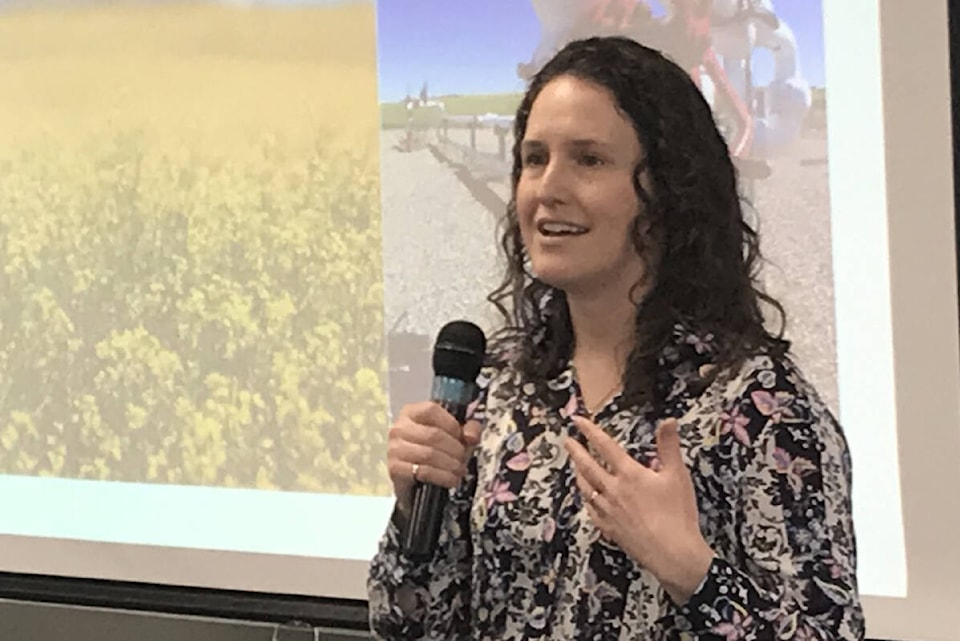Central Alberta has the geology, economics and know-how to become a world leader in the carbon net-zero chase, say carbon capture and waste-to-energy experts.
Varme Energy CEO Sean Collins and Candice Patton, vice-president of corporate affairs for Enhance Energy, brought enthusiastic messages about the prospects for creating a central Alberta carbon hub at a Red Deer and District Chamber of Commerce luncheon Tuesday.
Varme is building a facility to divert landfill waste and turn it into energy and heat while capturing carbon in Edmonton’s Industrial Heartland. A recently announced 15-year deal with the City of Edmonton will see about 150,000 tonnes of residential waste processed every year when the $300-million facility opens in 2027.
The company wants to follow that up with a similar facility in Innisfail that could process 100,000 to 200,000 tonnes of waste a year.
“We’re really invested in a low-carbon economy future. We see huge economic development and capital attraction opportunities in being able to deploy net-zero assets in the region,” said Collins.
Much of the central Alberta work so far has involved “chasing the waste,” building relationships with communities and lining up commitments to provide the necessary waste to feed the plant. Innisfail, Blackfalds, Sylvan Lake and Penhold have offered agreements in principle to supply their waste.
The facility has also been approved for collecting, sorting, processing and recycling waste under the province’s Extended Producer Responsibility Regulation.
Edmonton-based Varme, a subsidiary of Norway’s Green Transition Holding, sees significant low-carbon opportunities in the region.
“You are blessed in central Alberta as having some of the best geology in the entire world for carbon sequestration.”
The combination of geology and the existence of thousands of wells also means the region has some of the lowest carbon capture and sequestration costs globally.
Calgary’s Enhance Energy has also seen opportunity in the region building a $1.1 billion carbon capture and sequestration facility near Clive that last month celebrated permanently sequestering its five millionth tonne of carbon dioxide (CO2) underground in tapped-out oil reservoirs and will add close to two million tonnes every year.
“This is huge. Meeting a milestone like that is really big,” said Patton. “We’re one of the largest CCUS (carbon capture, usage and storage) projects in the world, certainly in Canada, and we’re just going to build from there.”
Patton said it is one of seven facilities in the world storing more than one million tonnes a year and one of the few companies that has managed to follow through on its ambitions.
The company is already building on its Clive success with the Origins Project, which is billed as open access CO2 sequestration hub using the already-built Alberta Carbon Trunk Line to help Alberta meet its 2050 net zero emissions target.
Central Alberta’s long history as an oilfield services centre means there is a “foundation of expertise” here, although challenges are emerging attracting new people to the industry.
Collins said the federal and provincial government financial support through tax credits has been crucial to the development of new projects.
To continue expanding carbon capture initiatives, carbon pricing, carbon credit and regulatory consistency are necessary while providing incentives for emerging industries.
Central Alberta Economic Partnership chair Jean Barclay said emergent industries, like those involving Varme Energy and Enhance Energy, are among seven sectors identified in the economic development organization’s growth strategy. The others are: agribusiness, transportation, logistics, manufacturing, natural resources and tourism.
Barclay called on all sectors to collaborate, including industry, non-profits, academia and municipalities.
“I will challenge all of us, let’s be that region that is bold and that comes together and that we really chart a prosperous path forward for all because we can do this we just need the willingness of everybody to come together and do it together.”
